DG meets with Tunisian Minister of Agriculture
CIMMYT’s director general Thomas Lumpkin met with Mohamed Ben Salem, the Minister of Agriculture of Tunisia, on 11 February 2012 in Tunis, Tunisia, during a visit to the region focusing on fortifying CIMMYT’s presence in Africa. From CIMMYT, Lumpkin was accompanied by Wilfred Mwangi, liaison officer for Africa, and Karim Ammar, head of the durum wheat program and a Tunisian national.
Wheat is currently the number one imported crop into Africa and, at approximately 216 kilos per person per year, the North Africa region has the highest wheat consumption per capita in the world. Tunisia already imports an estimated 2 million tons of wheat per year, and with low yields and a growing population, wheat production is a major concern for the country. 61% of Tunisia’s total land area is categorized as arid, and erratic rainfall and weather patterns are the primary concern for the country’s wheat producers. In 2010, for example, an extended period of drought halved the country’s wheat production. Diseases and pests such as Hessian fly also cause problems.
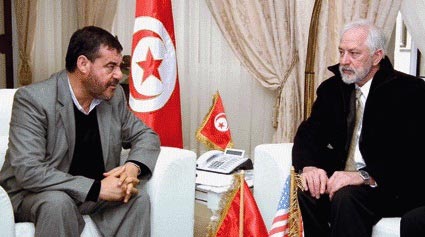
During the meeting, which aimed at re-establishing links and partnerships in the region, Lumpkin and Ben Salem discussed opportunities for activities in line with the WHEAT CGIAR Research Program (CRP) lead by CIMMYT in partnership with ICARDA. They talked about improved varieties and agronomic techniques developed at CIMMYT, and the potential for establishing a research platform in Tunisia aimed at achieving higher yields.
CIMMYT’s activities in Tunisia date back to the period 1966-1977, when a comprehensive project known as “The Wheat Project” was implemented by the Government of Tunisia, CIMMYT, USAID, the Ford Foundation, and the Rockefeller Foundation. The goals of the project were to introduce and adapt Mexican semi-dwarf high-yielding wheat varieties and to train Tunisian scientists in agricultural research and extension methods. During the project, 55 Tunisian nationals were trained at CIMMYT in Mexico, and to this day many refer to the varieties developed as “Mexican wheats”.
Lumpkin continued with his visits to the region by heading to Rabat, Morocco to meet with officials alongside Mahmoud Sohl, director general of ICARDA, to link activities in the region with the WHEAT CRP. He also joined CIMMYT’s Hans Braun, director of the global wheat program and Cheraé Robinson, director of fundraising and strategic partnerships, at the Global Food Security Forum, held in Rabat during 07-09 March 2012, where he spoke as a panelist on the subject of Investment and Innovation: Key Building Block of Food Security. Lumpkin will end his recent tour of Africa in Tanzania for the annual meetings of the Sustainable Intensification of Maize- Legume Cropping Systems for Food Security in Eastern and Southern Africa (SIMLESA) project at the end of March.
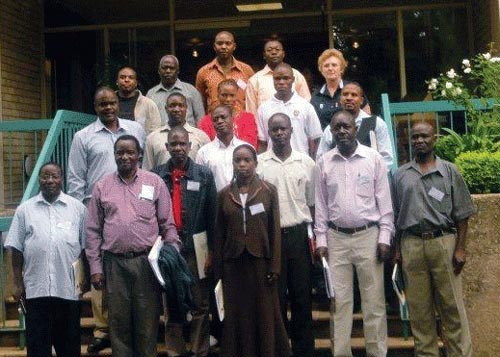
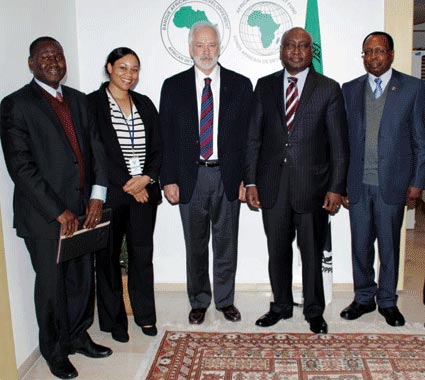 The group also discussed the MAIZE CRP and CIMMYT’s strong partnership with the International Institute of Tropical Agriculture (IITA). Institutional linkages such as these can be very beneficial to African smallholder farmers, as demonstrated by the major projects accomplished by CIMMYT’s Africa offices, such as Drought Tolerant Maize for Africa (DTMA), Sustainable Intensification of Maize- Legume Cropping Systems for Food Security in Eastern and Southern Africa (SIMLESA), Water Efficient Maize for Africa (WEMA), Insect Resistant Maize for Africa (IRMA), and Improved Maize for African Soils (IMAS). “CIMMYT has had an enormous impact on wheat in Africa. Most cultivars are CIMMYT derived and many wheat scientists from African NARS have been trained at CIMMYT,” said Ammar.
The group also discussed the MAIZE CRP and CIMMYT’s strong partnership with the International Institute of Tropical Agriculture (IITA). Institutional linkages such as these can be very beneficial to African smallholder farmers, as demonstrated by the major projects accomplished by CIMMYT’s Africa offices, such as Drought Tolerant Maize for Africa (DTMA), Sustainable Intensification of Maize- Legume Cropping Systems for Food Security in Eastern and Southern Africa (SIMLESA), Water Efficient Maize for Africa (WEMA), Insect Resistant Maize for Africa (IRMA), and Improved Maize for African Soils (IMAS). “CIMMYT has had an enormous impact on wheat in Africa. Most cultivars are CIMMYT derived and many wheat scientists from African NARS have been trained at CIMMYT,” said Ammar.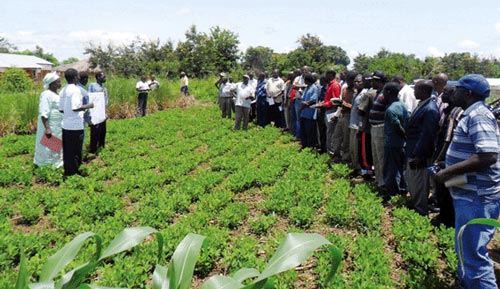 Since 2005, farmers, extension officers, and researchers have joined forces in starting a revolution from traditional farming systems in Malawi to locally adapted CA systems. The number of farmers practicing CA in the TLC communities of Central Malawi has grown from the initial 12 in 2005 to over 30,000 in 2012. This extension of CA was largely due to the development of an innovation network with different actors: Researchers assured training and quality implementation of the new technologies in target communities; the network facilitated participatory interaction and dialogue with farmers; and farmers raised social capital, subsequently boosting interest in the project within their own communities and the surrounding areas. These successful results enabled TLC and other partners to attract further funding and they linked farmers with input suppliers and a soft loan program for herbicides and improved seed. Farmers can currently access the input loan at seeding and pay back the amount for both inputs at harvest. Linking farmers to input markets was a major success, but more work needs to be done to also develop output markets for increased production from CA fields.
Since 2005, farmers, extension officers, and researchers have joined forces in starting a revolution from traditional farming systems in Malawi to locally adapted CA systems. The number of farmers practicing CA in the TLC communities of Central Malawi has grown from the initial 12 in 2005 to over 30,000 in 2012. This extension of CA was largely due to the development of an innovation network with different actors: Researchers assured training and quality implementation of the new technologies in target communities; the network facilitated participatory interaction and dialogue with farmers; and farmers raised social capital, subsequently boosting interest in the project within their own communities and the surrounding areas. These successful results enabled TLC and other partners to attract further funding and they linked farmers with input suppliers and a soft loan program for herbicides and improved seed. Farmers can currently access the input loan at seeding and pay back the amount for both inputs at harvest. Linking farmers to input markets was a major success, but more work needs to be done to also develop output markets for increased production from CA fields.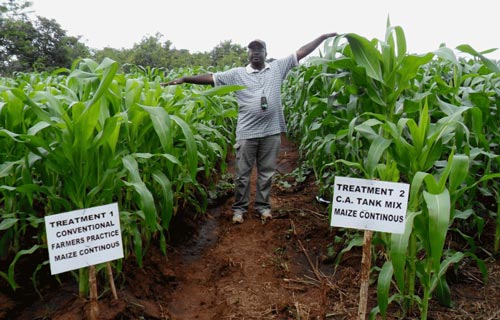 During 06-10 February 2012, a team of CIMMYT scientists travelled to six communities in Zambia’s Eastern Province to monitor progress on activities implemented under the Sustainable Intensification of Maize-Legume systems for the Eastern Province of Zambia (SIMLEZA) project, funded by USAID as part of Barack Obama’s “Feed the Future” initiative. The team was joined by national partners from governmental extension services, field coordinators from Total Land Care, Zambian researchers from Msekera Research Station, IITA, and CIP, and a group of farmers from Monze, in Zambia’s Southern Province. Journalists from two radio stations, one daily newspaper, and Zambian television covered the visit.
During 06-10 February 2012, a team of CIMMYT scientists travelled to six communities in Zambia’s Eastern Province to monitor progress on activities implemented under the Sustainable Intensification of Maize-Legume systems for the Eastern Province of Zambia (SIMLEZA) project, funded by USAID as part of Barack Obama’s “Feed the Future” initiative. The team was joined by national partners from governmental extension services, field coordinators from Total Land Care, Zambian researchers from Msekera Research Station, IITA, and CIP, and a group of farmers from Monze, in Zambia’s Southern Province. Journalists from two radio stations, one daily newspaper, and Zambian television covered the visit.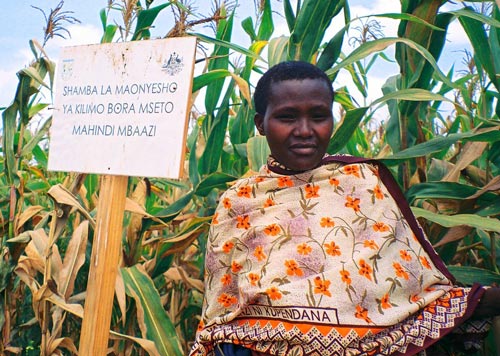 On 02 December 2011, the CGIAR celebrated its 40th anniversary. To commemorate this event, they are publishing stories illustrating the work of each of the CGIAR centers. Today was the turn of CIMMYT; go to the CGIAR website to read about how Felista Mateo is working with CIMMYT and the Sustainable Intensification of Maize-Legume Cropping Systems for Food Security in Eastern and Southern Africa (SIMLESA) project to plant new varieties of maize and pigeon pea using conservation agriculture techniques, thus increasing her yields and making her farming practices more sustainable.
On 02 December 2011, the CGIAR celebrated its 40th anniversary. To commemorate this event, they are publishing stories illustrating the work of each of the CGIAR centers. Today was the turn of CIMMYT; go to the CGIAR website to read about how Felista Mateo is working with CIMMYT and the Sustainable Intensification of Maize-Legume Cropping Systems for Food Security in Eastern and Southern Africa (SIMLESA) project to plant new varieties of maize and pigeon pea using conservation agriculture techniques, thus increasing her yields and making her farming practices more sustainable.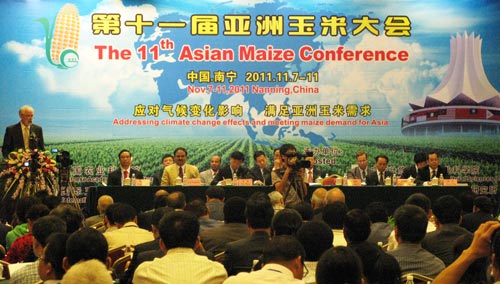

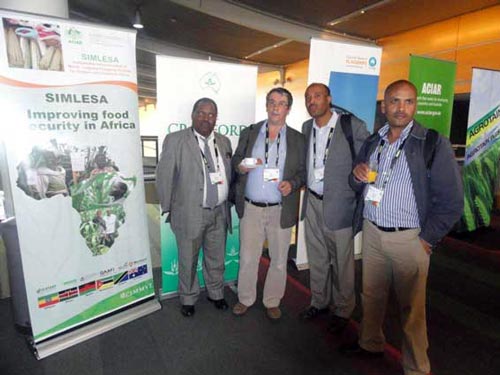 SIMLESA is funded by the Australian Center for International Agricultural Research (ACIAR), and led by CIMMYT. It is being implemented in collaboration with the national agricultural research systems of Ethiopia, Kenya, Malawi, Mozambique, and Tanzania; the International Crops Research Institute for the Semi-Arid Tropics (ICRISAT); and Australian partners including the Queensland Department of Employment, Economic Development and Innovation (QDEEDI), Murdoc University, and the University of Queensland. These partnerships with Australian universities, as well as with universities in Africa, have been key to building capacity through short-term training and postgraduate fellowships for researchers. Adopting the Innovation Platform framework, further co-operation with a range of private and public sector organizations, NGOs, and famers’ organizations in Africa has meant the project has been able to quickly and effectively reach farmers on the ground with outputs such as varieties and technologies.
SIMLESA is funded by the Australian Center for International Agricultural Research (ACIAR), and led by CIMMYT. It is being implemented in collaboration with the national agricultural research systems of Ethiopia, Kenya, Malawi, Mozambique, and Tanzania; the International Crops Research Institute for the Semi-Arid Tropics (ICRISAT); and Australian partners including the Queensland Department of Employment, Economic Development and Innovation (QDEEDI), Murdoc University, and the University of Queensland. These partnerships with Australian universities, as well as with universities in Africa, have been key to building capacity through short-term training and postgraduate fellowships for researchers. Adopting the Innovation Platform framework, further co-operation with a range of private and public sector organizations, NGOs, and famers’ organizations in Africa has meant the project has been able to quickly and effectively reach farmers on the ground with outputs such as varieties and technologies.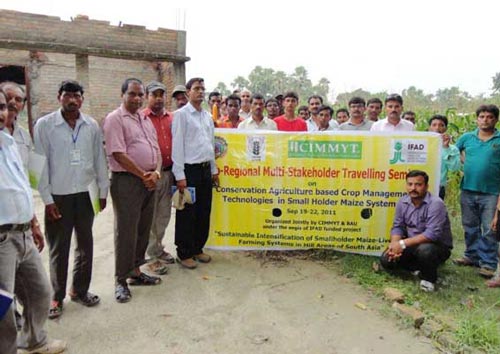 During 19-22 September 2011, Birsa Agricultural University (BAU), Jharkhand, India, hosted the Sub-Regional Multi-Stakeholder Travelling Seminar entitled “Conservation Agriculture Based Crop Management Technologies in Smallholder Maize Systems.” Organized jointly by BAU and CIMMYT-India, under the aegis of the IFAD “Sustainable Intensification of Smallholder Maize-Livestock Farming Systems in Hill Areas of South Asia” project, the seminar was attended by 37 scientists, extension agents and NGO representatives, students from Krishi Vigyan Kendra’s (KVKs) and BAU, and farmers from the three districts of Jharkhand.
During 19-22 September 2011, Birsa Agricultural University (BAU), Jharkhand, India, hosted the Sub-Regional Multi-Stakeholder Travelling Seminar entitled “Conservation Agriculture Based Crop Management Technologies in Smallholder Maize Systems.” Organized jointly by BAU and CIMMYT-India, under the aegis of the IFAD “Sustainable Intensification of Smallholder Maize-Livestock Farming Systems in Hill Areas of South Asia” project, the seminar was attended by 37 scientists, extension agents and NGO representatives, students from Krishi Vigyan Kendra’s (KVKs) and BAU, and farmers from the three districts of Jharkhand.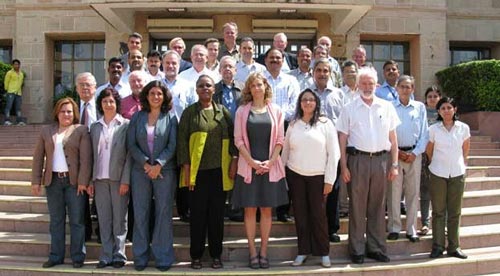
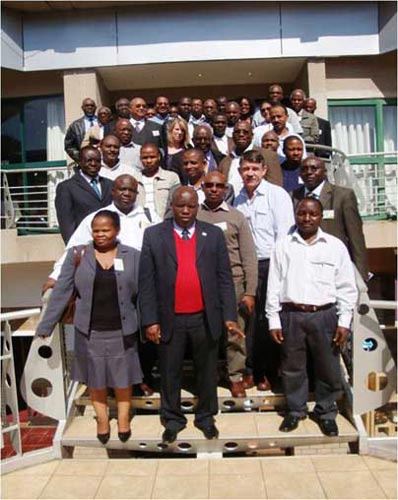 Edison Wotho, Deputy Permanent Secretary, Ministry of Agriculture, Botswana, praised Botswana’s participation in NSIMA, whose products for that country’s farmers include a new drought tolerant maize hybrid (CZH0623) and three OPVs (ZM309, ZM401 and ZM523). “The projects come at the right time,” said Wotho. “The region is experiencing frequent droughts and food shortages.”
Edison Wotho, Deputy Permanent Secretary, Ministry of Agriculture, Botswana, praised Botswana’s participation in NSIMA, whose products for that country’s farmers include a new drought tolerant maize hybrid (CZH0623) and three OPVs (ZM309, ZM401 and ZM523). “The projects come at the right time,” said Wotho. “The region is experiencing frequent droughts and food shortages.”